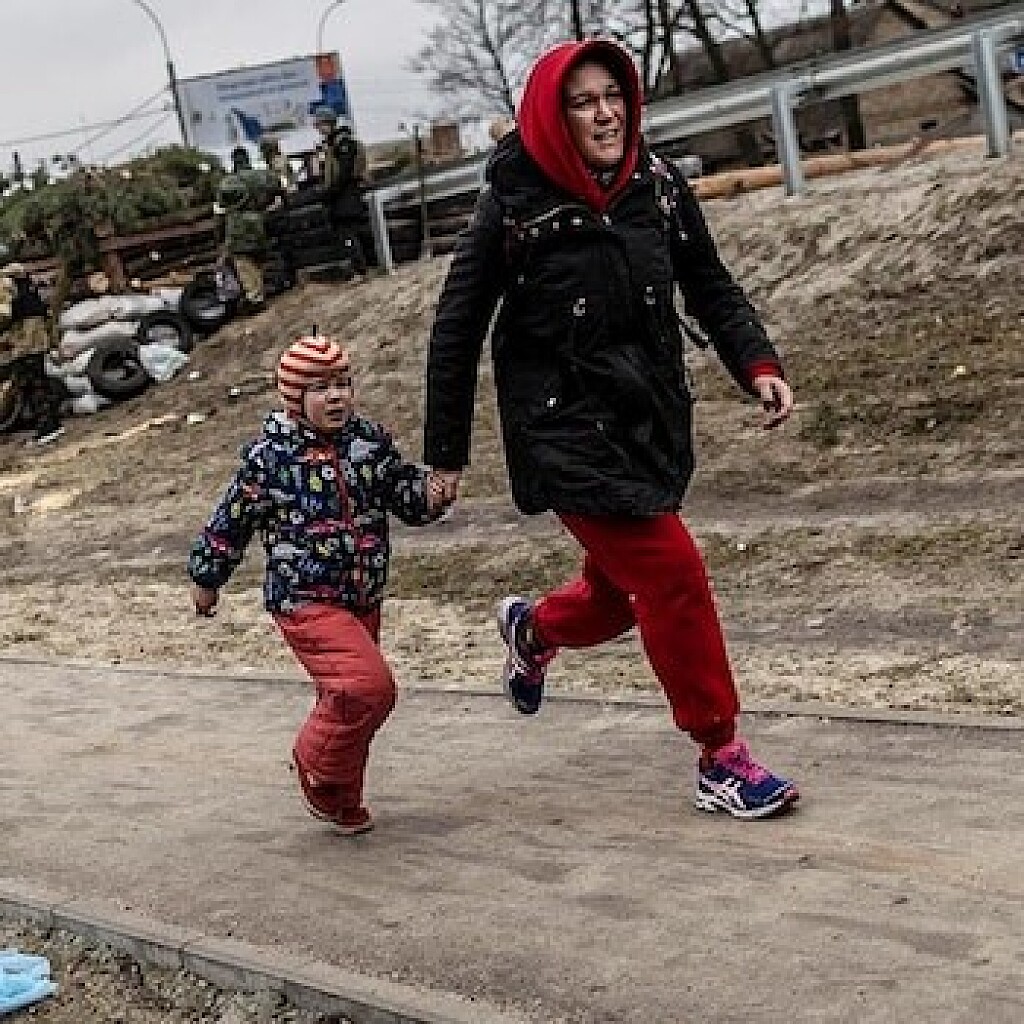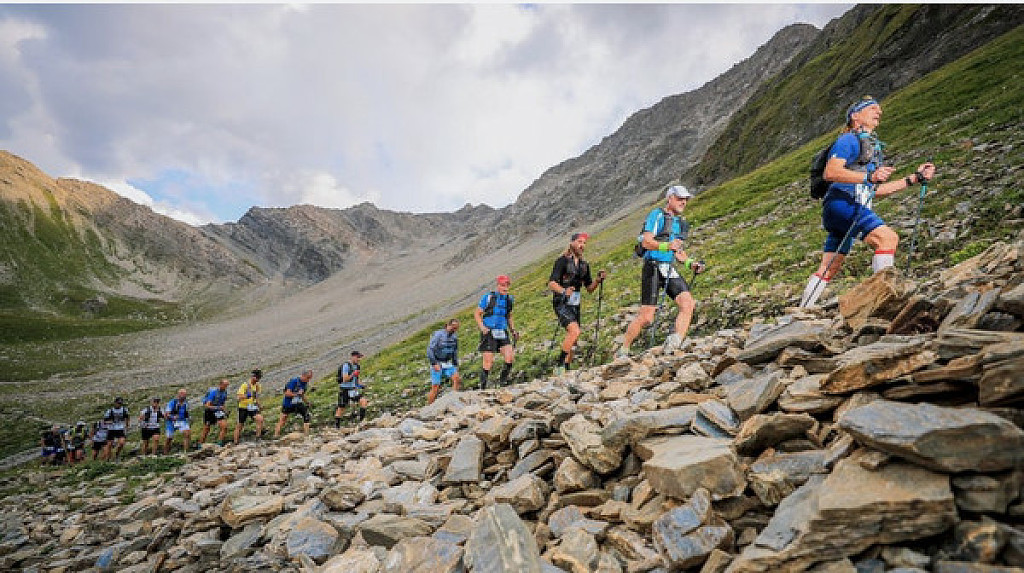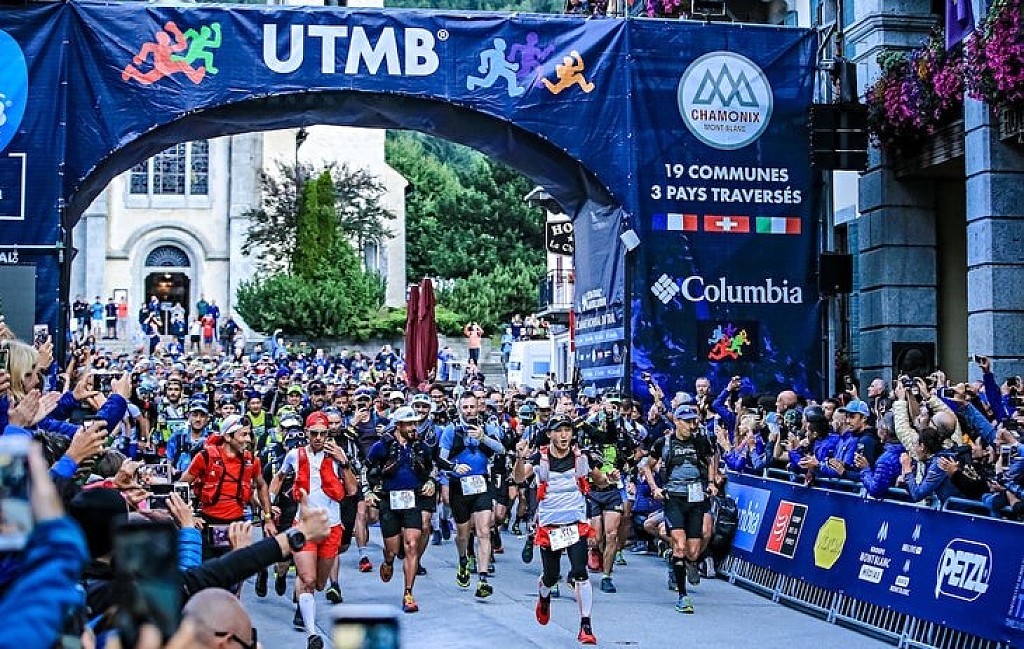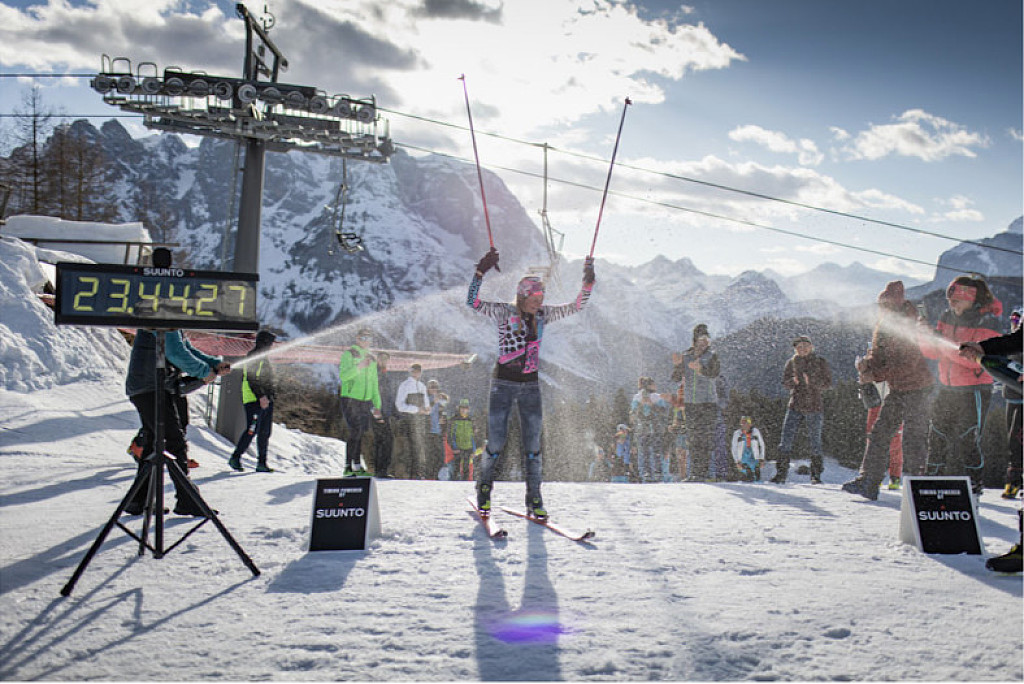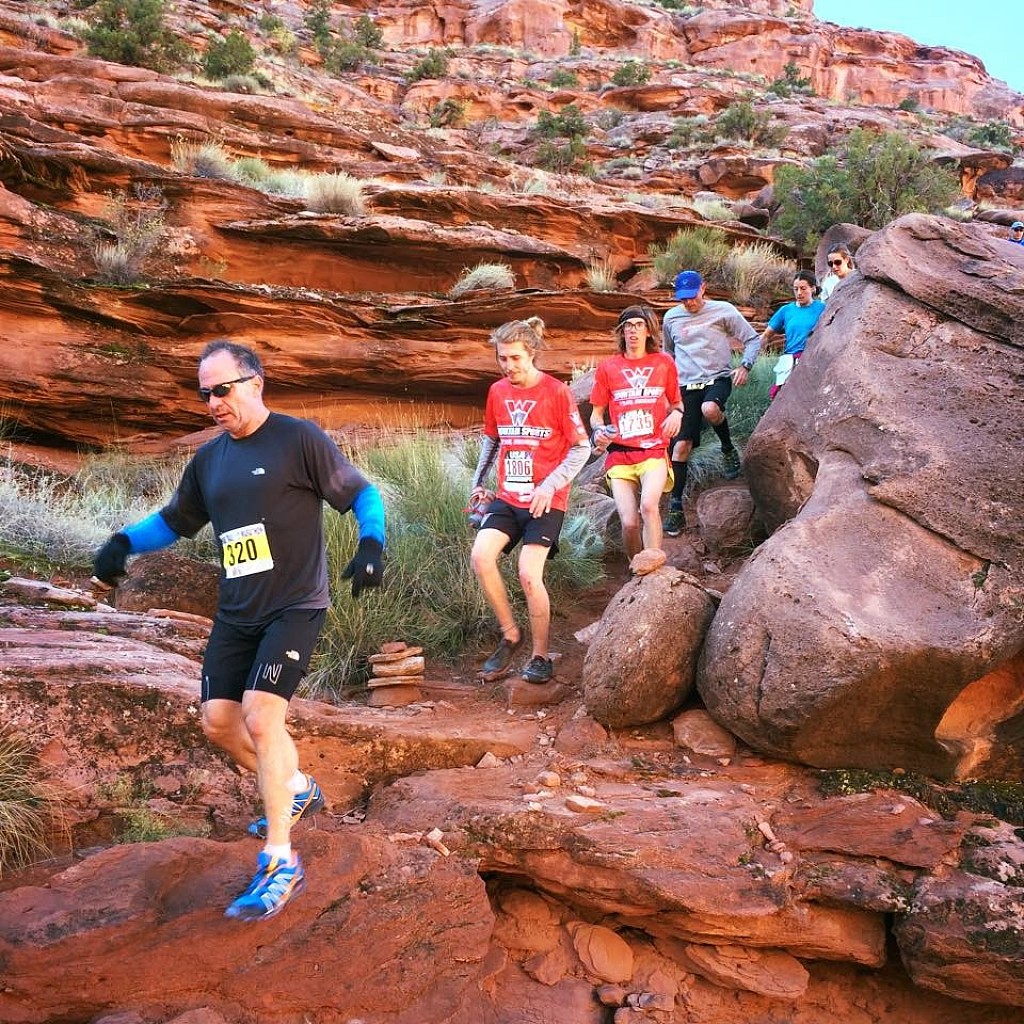Running News Daily
Running News Daily is edited by Bob Anderson. Send your news items to bob@mybestruns.com Advertising opportunities available. Train the Kenyan Way at KATA Kenya and Portugal owned and operated by Bob Anderson. Be sure to catch our movie A Long Run the movie KATA Running Camps and KATA Potato Farms - 31 now open in Kenya! https://kata.ke/
Index to Daily Posts · Sign Up For Updates · Run The World Feed
Articles tagged #Trail Runner Magazine
Today's Running News
Inside the War: Dispatches From a Ukrainian Race Director
On February 24, after Russian forces invaded Ukraine and ignited one of the largest conflicts Europe has seen since 1945, Trail Runner Magazine reached out to the country's running community in support, to learn more about what's happening on the ground, and provide a platform in solidarity.
(My Best Runs wanted to share this with our readers. What is happening is terrible and we must tell the world what is going on there.)
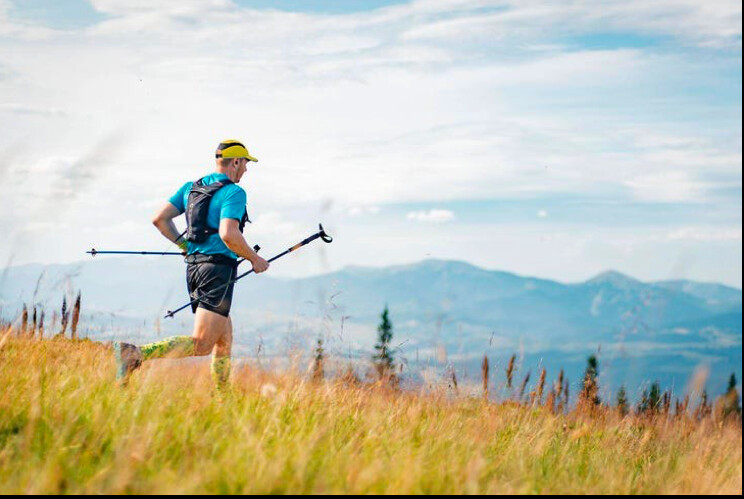
We quickly connected with Yaroslav Turenko in Lviv, western Ukraine, who is the race director for one of the country's largest trail races, the Lviv Ultra-Trail series. Turenko is a passionate trail runner, volunteer, and photographer. Here's what he had to say:
Nicholas Triolo for Trail Runner: Can you tell us what it's like on the ground where you are? What is the general sentiment of the Ukrainian people right now?
As you've likely heard, the worst-case scenario in Ukraine is unfolding. We are facing horrible acts of Russian aggression. They have invaded our country and have started to kill innocent people, bombing our cities, military, and civilian infrastructure. Their military is using the most inhumane methods: local populations used as human shields, women and children dropped off when attacking armored vehicles. The occupiers have killed children, shooting them at point blank.
These are war crimes. Crimes against humanity using tactical weapons of mass destruction, prohibited weapons, and ammunition. Many people in the world think this war is far from Central Europe, but a Russian missile was just dropped on a Ukrainian military base, located 24 miles (40 km) from the European Union border.
We've lost unique Ukrainian works of art in fires, along with the largest plane in the world - Ukraine's Antonov-225 cargo plane - destroyed by Russian strikes outside Kyiv.

But Ukraine is united like never before; all of our internal political disagreements are in the past. All the Ukrainians inside the country and abroad are doing everything possible to stand up and give a proper fight to Russian forces. We ask the international community to stand with Ukraine. But we need international support. We need shelter for our families. We need to close off air traffic from Russia. We need equipment for our defenders and sanctions for Russia.
Andrii Tkachuk, the world record holder in the 48-hour treadmill race and the national record holder in 24- and 48-hour ultramarathons, is currently defending the country in the Ukrainian Armed Forces.
TR: The city of Lviv, where you are, is located in the western part of Ukraine, far from the Russian border. Are you in any immediate threat? Are you in touch with people in Kyiv and other places currently under fire?
We are supporting each other, yes. Everyone in Ukraine can find shelter here in Lviv (pronounced "Luh-VEEV"). However, there is no guarantee that Lviv is a safe place, but right now we see a significant difference between Lviv and other cities in central and eastern Ukraine.
Lviv is a hidden gem of Europe. It's a charming, bohemian city, a UNESCO World Heritage site. It's the city of cafes and pubs, and some surprisingly awesome trail running. There will be no more Lviv Ultra-Trail until the enemy is defeated. Lviv is amazing, remarkably inexpensive by European and international standards, and I sure hope that the Lviv Ultra-Trail will take place again.
TR: Are you turning to your local trail running community for support right now? What can trail and mountain running do to help promote peace and understanding in the world?
We sent all the money from the Lviv Trail Running Club bank account to raise funds for the Ukrainian Armed Forces. Other organizers and trail communities have done the same. All volunteers involved in initiatives related to this development are working with refugees, blood donation, first aid, and cooking food for large groups of people.
Andrii Tkachuk, the world record holder in the 48-hour treadmill race and the national record holder in 24- and 48-hour ultramarathons, is currently defending the country in the Ukrainian Armed Forces.
We are kindly asking the International Skyrunning Federation (ISF) and International Trail Running Association (ITRA) to ban all Russian race evaluation and certification. As far as we know, the Lviv Ultra-Trail banned Russian runners after the annexation of Crimea, and the war in Donbas and Luhansk regions. We are calling for the ban of all Russians from international events like the UTMB World Series, the Golden Trail series, and others sponsored by ISF and ITRA.
TR: Pivoting away from the invasion for a moment: How would you describe trail running in Ukraine to someone who doesn't know much about your country?
Trail running in Ukraine has been developing extremely fast. Every year, the number of events and participants has grown. Among the most popular trail running events are the Tvoya Prygoda Series, Fun Carpaty, Lviv Ultra-Trail, and Ukrainian Trail League series.
Ukraine is a beautiful country with extraordinary nature and breathtaking landscapes, which makes it possible to run trails in nearly every part of our land, year round. The best place for trails, in my opinion, are the Carpathian Mountains, with some peaks above 6,500 feet (2000m) above sea level, with high humidity in every season. (Mount Hoverla is Ukraine's highest peak at 6,762 feet).
Serhii Popov is considered one of the fastest trail runners in Ukraine. He has won national trail and long distance mountain running championships almost every year since 2015, and took part in nine world championships. He is also an ultrarunner with the best national performance time in the Men's 40+ age group for 50K and 100-mile road races.
On February 24, Popov planned to fly to Spain, to take part in a six-hour ultrarunning event in Barcelona, with the goal to set another national record. But in the morning, he woke to bombing sounds from the Boryspil airport, where he was planning to depart a few hours later.
"The first night we spent in the basement of our friends in Irpin, near Kyiv," said Serhii. "It is right next to the Hostomel airport where fighting with the Russians just started. Explosions were so loud that the walls shook. This continued in the morning and we decided to reach the city of Zhytomyr, where my wife's parents were, and our car. As soon as we got to the city, we realized the return trip was not possible, so we decided to stay there and do what we could.
"I could not join the local defense forces. They are only taking people with appropriate combat experience, which I don't have. So we went to shops and carried food and water to block posts," Serhii said.
"The city of Zhytomyr is preparing to meet the enemy. Everybody in the city is trying to help - building fortifications, collecting all the army needs. We often will hear sirens and sometimes the sounds of explosions. But mostly people are calm and ready to stand up for their land."
by Trail Runner Magazine
Login to leave a comment
The Science Of Why Consistency Creates Fitness (Even 10 Minutes At A Time)
There are 4 physiological reasons why consistent runs have an oversized effect on long-term growth. On a tough day, even 10 or 20 minutes can be plenty to spur progress.
In 2006, a few months after quitting football in college, I went for the first endurance run of my adult life. I had big dreams! During that downtime between sports, I read training books and message boards, planning my next athletic steps. It was like “The Decision” by LeBron James when he announced he was taking his talents to South Beach–I was going to take whatever talents I had to running.
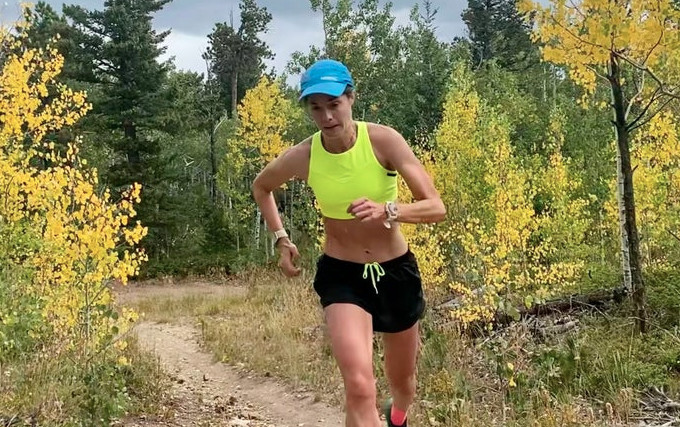
Maybe I’d walk onto the track team. Maybe I’d win some races! Running watched my announcement on ESPN, and as I put on my old basketball shorts and laced up my new Nikes, it responded like only running can:
“Go screw yourself. This is hard.”
I got a few minutes up the driveway before I sputtered to a stop. My calves were sore for days. Those dreams were going to need to be on a delayed fuse.
But something started on that run, deep in my physiology. The next one a few days later was a bit easier. It was still impossible and terrible, but at least I could walk the next day. Mile or two by mile or two, I got a bit stronger and a bit faster. In those training books, I had read about weekly miles and workouts and all of these complex training principles that made me miss the forest through the trees.
I didn’t need to have a forest on day 1, or even on day 1000. I just needed saplings. Hundreds of saplings. Thousands of saplings! It’s all about those bomb-ass saplings!
For me, a little over 2000 days later, it led to an overnight success at the 2012 US 10k Championships, where I won and was interviewed by Alex Kurt for Trail Runner Magazine. Those little runs led to adaptations which supported bigger runs, which supported bigger risks, and one of those risks led to a post-race interview with this magazine. A few years later, Alex helped me find a writing opportunity, and that writing opportunity is why you are reading this article today. Give a sapling 15 years, and very cool things can happen.
We see that process over and over in coaching.
An athlete will break out onto the international stage, with an overnight success that was thousands of days in the making. To paraphrase Once A Runner, everyone wants to know The Secret. The unglamorous answer is that there are two ingredients that really matter: consistency and time. Remove the molecules on the bottoms of many pairs of training shoes, one little run at a time.
Those first runs I did were 10 to 20 minutes, and I owe them everything. Even now, I’ll often do very short runs as doubles, or on busy days when nothing else works. Seeing how these short runs can support long-term adaptation, my wife/co-coach Megan and I made a rule for our athletes: “give us 10 minutes” (we talk about it on our podcast here). If there’s a run on the plan, even when life happens, try to do a short jog.
It can be up and down the stairs in your work clothes while preparing for a trial, barefoot around the house on a smoky day with no treadmill available, a lap of the block when anxiety makes it impossible to think about more. Whatever the cause of the compressed run, it’s not a mental trick. We aren’t saying: “Maybe they’ll actually do the full run after they get out there.” We definitely aren’t adding: “Mwhahahahaha!”
For us, it’s all about the physiology of how an athlete can adapt to frequent, consistent running over time. There are four general mechanisms we focus on.
One: Musculoskeletal adaptations
In the endurance world, running is unique because of impact forces. Each step involves the absorption and transmission of multiple times body weight! Don’t think about that too hard, or you’ll start having erotic dreams about joint pills.
That force causes massive stress on bones, tendons, ligaments, and muscles. With bones, osteoblasts and osteoclasts adapt to each minor stress. But the line between a stress reaction and healthy adaptation is blurry. For example, a 2006 study found that 9 of 21 collegiate runners measured had asymptomatic tibial stress reactions on MRI, with no correlation to subsequent clinical outcomes. In other words, the constant force absorption of running created a background stressor on the bone that likely made it bounce back stronger for those athletes. But it easily could have resulted in full-blown stress fractures too. Consistent, low-level stress helps the body manage these adaptation processes without needing a punch card at the local MRI joint.
Soft tissues work the same way, with each low-level stress spurring strengthening processes. Muscle fiber growth and recruitment is enhanced by consistent stress/recovery cycles, and when the body is transmitting so many tons in such a short time, those stresses don’t need to be long to encourage adaptation. If hypothetical runner A goes out for 1 hour 3 times per week and runner B does 30 minutes 6 times per week, I think runner B not only stays healthier, but goes way faster too, even at longer distances.
Two: Aerobic and metabolic adaptations
A major friction point for aerobic development is the transportation of oxygen-rich red blood cells to working muscles via capillaries. Running induces angiogenesis, or increased capillarization. Studies on mice involving deep muscle biopsies show that the adaptations can happen with relatively short bouts of exercise on the most adorable mouse treadmills, and the adaptations start to reverse with significant downtime. It works similarly in humans, but there aren’t too many volunteers for the study protocols. While lots of aerobic time is good, any amount can keep those adaptations going. That’s why 10 or 20 minutes can be so much more valuable than taking a zero, especially over longer time horizons.
Simultaneously, after consistent stress, cardiac output increases, with blood volume increasing by up to 20%. Those adaptations don’t take much time investment either, with the bulk of the changes happening relatively early in runs. Running also jump-starts the metabolic system, increasing metabolic rate at rest and reducing it during activity, with improved fat oxidation from repeated endurance stress.
Endurance athletes are sometimes hurt by the attitude that “if some is good, more is better.” That impulse may lead to athletes getting into endurance in the first place, because why else pursue these wild feats of force absorption and aerobic demand? But I think that the statement implies a faulty adaptation relationship. If more is better, then each subsequent mile is more valuable than the one before it, right?
That’s likely untrue. Each subsequent mile is probably slightly less valuable than the one before it from an adaptation perspective, with rapid initial stress causing a boatload of early adaptations. A more accurate physiological description might be: “if some is good, more isn’t quite as good as a per-unit measure, but it will accumulate on top of the good as long as an athlete avoids overstress.” I am not fun at parties.
Three: Neuromuscular and biomechanical adaptations
The nervous system is wild. Through an immensely complex layering of voluntary and involuntary signals, the brain coordinates running, playing the piano, and masturbation, sometimes in sequence with transition areas if you don’t understand all the rules to triathlon. And it’s not just coordinating movements, but also determining how an athlete perceives effort, responds to stress, and adapts over longer-term cycles. It’s not all in our heads, but a lot of it is, just not in a way we always control.
With consistent training stress, running economy improves dramatically as a given output takes less energy. That’s what happened to me when I first started. I was able to get faster while going longer and using less energy because the nervous system interacted with the musculoskeletal and aerobic systems to make running more efficient. That’s a journey every runner faces at first, and it’s so daunting because the simple act of running is actually very, very complex. Whether it’s running or dancing, repetition is a key element for nervous system changes.
Consistent reinforcement is key, and even short runs do the trick. Add some intensity like hill strides, and running economy can go through the roof relatively quickly.
Four: Epigenetic and cellular-response adaptations
Genetics is like being dealt a hand of cards. Epigenetics is finding out that it’s you’re working with a special deck, where you can swipe a jack into an ace, or a heart into a spade. Environment and behavior influence the expression of our underlying genetic codes, with extra-long-term changes likely stemming from weakly understood interactions at levels way, way smaller than cells.
How can we determine our genetics? Take a spit test and wait a few decades as the algorithms determine what base pairs are generally associated with athletic performance.
How do we determine our epigenetics? Run consistently for thousands of days and see what happens.
While we are probably not that far from being able to correlate complex individual skills to genetic predispositions, it will be impossible to do with certainty for the foreseeable future because of the murky world of epigenetic interactions. Small, consistent stimuli may help turn some of those epigenetic switches toward endurance. That could explain how athletes can undergo such stunning changes over time (like my own personal change from a bench-pressing football player to a feather-pressing mountain runner).
Throw in other uncertain variables, like endocrine system changes and protein expression shifts. Then mix all of that with the psychology of habit formation, goal-setting, and time management.
Put all of that together, and I am still not sure the exact best way to find your ultimate potential. But I know it involves the consistent accumulation of thousands of running days.
And 10 minutes can get you one day closer.
by Trail Runner Magazine
Login to leave a comment
Czech Runner Dies from Falling During UTMB’s TDS Race in Chamonix
It is believed to be the first death in the 19-year history of the Ultra-Trail du Mont-Blanc races in and around Chamonix
There was sad news coming out of Chamonix, France, early on the morning of August 25.
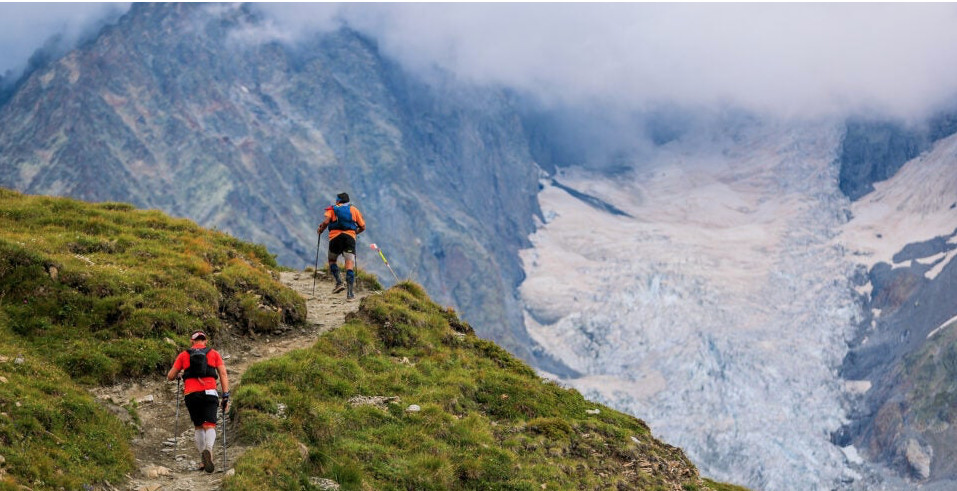
The Ultra-Trail du Mont-Blanc race organization reported that a male runner from the Czech Republic competing in the 145-km TDS race died after suffering a bad fall and serious injuries. The accident occurred at the 62.3 km mark on the descent of the Passeur de Pralognan, an 8,421-foot mountain pass west of Chamonix, France.
It is believed to be the first death in the 19-year history of the Ultra-Trail du Mont-Blanc races in and around Chamonix.
A spokesperson for the race said the UTMB race organization is deeply saddened and wished the international trail running community to join in offering condolences to the family and friends of the victim.
When the accident occurred at 12:25 a.m. CET, the rescue team stationed on the course responded to the scene immediately and additional emergency personnel was called into action via helicopter support. Despite life-saving treatments, the runner (who is being kept anonymous until all family members have been notified) succumbed to his injuries. Because of the remote and complex nature of the rescue operations, the race was partially halted and the runners located at the Passeur de Pralognan, and further back, were instructed by the race committee to turn around and go back down to Bourg Saint-Maurice, where they were met and transported back to Chamonix.
The race began on Tuesday afternoon in Courmayeur, Italy, and runners experienced clear skies and cool temperatures through the night and into the early morning. The 293 runners who had already run through Passeur de Pralognan were allowed to continue on to finish the race, but the remainder of the approximately 1,200 runners who were turned back will not be able to continue.
Norway’s Erik-Sebastian Krogvig was the eventual winner of the TDS, making it back to Chamonix after 18 hours, 49 minutes, 58 seconds. The TDS race, officially known as the Sur les Traces des Ducs de Savoie, is the most technically challenging race during the UTMB week, with several craggy climbs and descents that require precise footing and balance.
“This is a tough section of the course,” reports Trail Runner Magazine contributor Doug Mayer, who lives in the Chamonix area. “You’ve just climbed 2,000 meters in about 10 km, then need to hold on to chains on the other side. They have a rescue group right there at this spot, always. It’s the most technical moment of the race.
Login to leave a comment
North Face Ultra Trail du Tour du Mont-Blanc
Mountain race, with numerous passages in high altitude (>2500m), in difficult weather conditions (night, wind, cold, rain or snow), that needs a very good training, adapted equipment and a real capacity of personal autonomy. It is 6:00pm and we are more or less 2300 people sharing the same dream carefully prepared over many months. Despite the incredible difficulty, we feel...
more...Ultra-Trail du Mont-Blanc Partners with Ironman
Trail running grows up, and with it comes an uncertain future.
Did you feel the ground shake under the trail during your last run? You might have. Because this morning at 10 a.m. Paris time, Chamonix, France, was the epicenter of an earthquake that radiated outward and shook the trail-running world. The Ultra-Trail du Mont-Blanc, our sport’s most prestigious week-long series of ultramarathons, just announced that it is partnering with Ironman, the global triathlon brand. The partnership is comprehensive and international in scope. It’s a fitting moment for the world’s most iconic race, which turns 18 and enters adulthood this year.
The announcement was surprising-not-surprising. The not-surprising part? Trail running has reached critical mass and continues to grow, and for private-equity investors that means that the sport is officially on the radar. On top of the numbers, the trail-running demographic is a desirable one for investors.
“Healthy living is really on fire with investors right now. People have seen companies like Peleton do really well,” says David Lavallee, a former investment banker who lives in Chestnut Hill, Massachusetts, and now invests and operates endurance-related companies. Lavallee sees opportunity within the sport, too. “Trail running has been synonymous with ultras for the last 20 years. But there’s huge room for downward growth, for individuals who want to run a 10K trail race.” And as more people experience trail running? “That fuels the understanding that there’s something really big going on here,” he says. “And it has all been amplified by the pandemic.”
Media Mashup
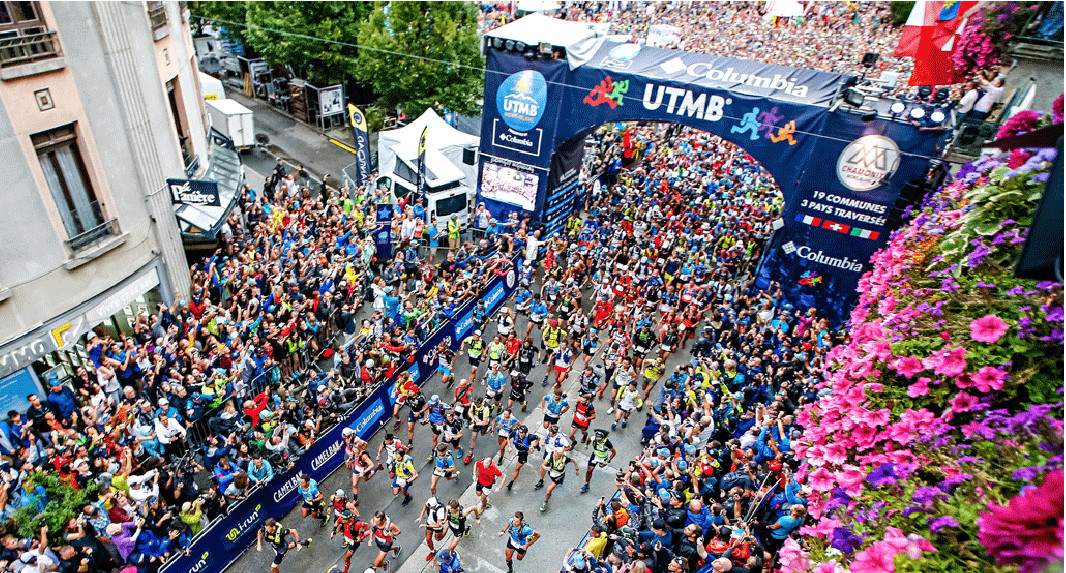
In the trail-running-media world, dollars are already flowing in. U.S. trail-running publishers have been snatched up by larger entities. The website irunfar.com has gone to Lola Digital Media, owner of a dozen other outdoors-oriented publishers, among them Gear Junkie. Trail Runner magazine was acquired last October by Pocket Outdoor Media, which subsequently bought Outside Magazine, and now operates under that iconic publisher’s brand name. Last September, the investment division of Nashville software company Atiba Labs purchased the website ultrasignup.com from its founder, Mark Gilligan.
In the case of the new UTMB-Ironman partnership, Ironman’s investment only goes so far. According to UTMB, their company has the majority ownership; Ironman has a minority stake, and there is no option for Ironman to take control of UTMB. Ironman presence at UTMB events will be low key, as well, with no Ironman branding at UTMB races.
“Ironman is a long-distance-triathlon brand,” said Andrew Messic, CEO of the Ironman Group, “and we intend to keep it that way.”
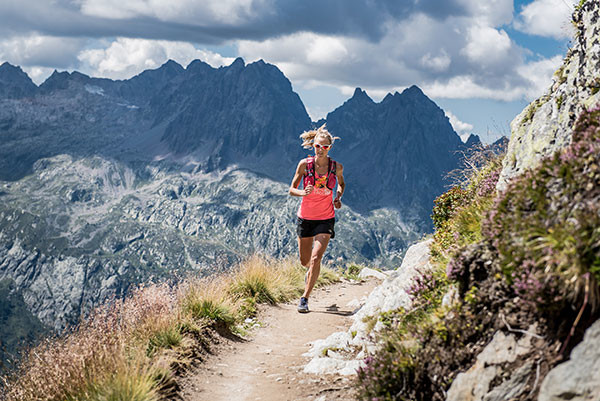
How It Will Work
The surprising part? It really did happen, and now the trail-running world has to think about what comes next. The announcement of the UTMB-Ironman partnership brings with it the potential for deep changes to trail racing, for example. UTMB is calling its new global race series the “UTMB World Series,” which breaks down into four categories of races: World Series Qualifiers, Events, Majors and Finals. Qualifier races, whose numbers will apparently be in the thousands, give “privileged access” to World Series Events and World Series Majors, both of which feature 50K, 100K and 100-mile distances. Each World Series race gives a participant one lottery entry (UTMB calls them “stones”) to the finals in Chamonix. The World Series Majors are the flagship races on each continent, with two entries to the Chamonix lottery. Between the Majors and Events categories, UTMB expects to have 30 to 40 races take part.
Everything points toward Chamonix and the World Series Finals—and the only way to get there will be through the new race series. To get to Chamonix, runners will also need to finish a race of comparable difficulty in one of the other UTMB race series.
Notably, no U.S. races were announced as part of the press release. “Trail running was born in the USA… [but] it’s not easy for a French company to develop something [there],” said UTMB Co-Founder and Co-Owner Michel Poletti. “That’s part of our decision to partner with Ironman, is that it will be easier for them to develop the sport in the U.S. than for us in France.” Poletti noted they are talking with “many other races in the world, including the United States.”
The current Ultra Trail World Tour, in which UTMB owns a controlling interest, will cease to exist in January 2022. Some of the races currently in that series will join the new UTMB World Series Majors. Meanwhile, the other UTMB races that take place in Chamonix, MCC (40K), TDS (145K) and PTL (300K), will continue, with race registration procedures that will be announced this fall, according to UTMB staff.
What Does It Mean For Trail Running
In the trail-running world, Ironman is not without its branding challenges. Corte Madera, California’s Jeri Howland, 65, has known both the trail-running and Ironman world for several decades. She’s ticked off 21 Ironmans, is a seven-time champion, and at age 46 set an age group world record. When it comes to trail running, she’s won her age group in over 30 races and twice has been female champion in the Bay Area’s legendary Quad Dipsea race. She spoke to Trail Runner broadly on the idea of Ironman possibly entering the trail running.
“Ironman would bring in a lot of hype,” says Howland. “They think it’s part of the attraction. I don’t think trail runners would like that.”
Culturally, at first glance, the two worlds do seem somewhat at odds. “Triathletes have a ‘look,’ dressed in the latest gear,” Howland says. “Runners are simpler and colors are muted. One is glossy and the other is matte.” It’s a polite tension that already exists in the trail running world—between European runners in their pricey “kits” and American runners, for whom duct tape and shirtless running are their own form of fashion statement.
Fashion aside, Howland thinks that trail running could ultimately benefit. “Once triathletes realize how great the return on investment is for them in ultrarunning, they may turn to the sport. It’s much simpler than taking a bike and wetsuit with you. And triathletes are always looking to expand their endurance capacity. They’d jump in.”
And, always, there is the profit motive, as both UTMB and Ironman are for-profit entities, and the latter sometimes seems intent on pushing the envelope on pricing boundaries. During the pandemic, Ironman offered deferments but refused to offer refunds. Many registered athletes were irate, and filed a class-action lawsuit, which was summarily dismissed by a US District Court Judge this past January. Even in more normal times, says Howland, “The cost of Ironmaning is off the charts.” Will that pricing come to UTMB? “That could be a huge turn-off,” says Howland. “Triathletes expect to spend a lot of money,” she says. “Trail runners don’t.” For his part, Poletti offered awareness of that concern, saying, simply, “We want to deliver high standards events at a fair price.”
One clear benefactor in the new partnership will be Chamonix, France. Already considered by many to be the world’s home of trail running, the town also hosts CMBM, one of the largest trail-running clubs in the world, the eight races of the Mont Blanc Marathon in late June, and the more under-the-radar Trail des Aiguilles Rouges in late September, three races whose marquee event is a highly technical 54K route. All of the new UTMB-Ironman races will point toward a climax at the end of August in Chamonix. An estimated 130,000 runners, family, friends and fans already converge on the Mont Blanc region at the end of each summer. It’s hard to imagine that number getting any smaller. And if the triathlon world shifts its attention to UTMB and starts trail running? Those numbers will keep growing, even with entrance caps on the races.
What Comes Next
Perhaps more interesting than the announcement itself, is what comes next. Will the trail-running culture embrace a “big tent” approach and accept corporations with deep pockets and little history in the sport, alongside diehard trail runners who toe the line each weekend in local races that finish with beers back at the trailhead? Is there room for both in trail running?
“This is essentially one of the big debates of the sport coming to a head: what is trail running all about?” says Hillary Gerardi. Originally from Vermont, Gerardi has set course records on technical trail races around the world. She is sponsored by the Utah-based company Black Diamond. Gerardi has lived in France for ten years, the last four in Chamonix. “We’ve been wrestling with that question for the past decade as the sport grows and evolves.This partnership between UTMB and Ironman is a big jump. It’s forcing people to decide where they stand on the issue.”
“This is an interesting arrangement and one that brings a lot of unknowns,” says Brian Metzler, the founding Editor of Trail Runner magazine, who now serves as a Contributing Editor and freelances for numerous media outlets. “Of course, some purists will criticize it as being a bad thing that’s contrary to the easy-going, community spirit that we all know and love.”
Metzler has completed four Ironman triathlons and has run two of UTMB’s races, CCC and OCC. He’s also run the UTMB course, and knows the Chamonix scene well, having been to nine editions of UTMB. And while he’s concerned that the UTMB qualifier events might become cost prohibitive for some runners, he is optimistic that the UTMB-Ironman relationship could yield positive results. “I think it could add structure, professionalism, exposure and prestige that could benefit elite athletes in the same way the Ironman World Championship in Kona has for triathletes.”
And for eager recreational runners? “It’s an inspiring incentive to travel to unique events with the hopes of getting to the UTMB in Chamonix.” And as Metzler is quick to point out, it was already hard to get to a starting line in Chamonix. “Let’s face it, UTMB was already impossible to get into just as getting into Kona was before qualifiers were developed 25 or 30 years ago.”
The dust is still in the air. When it all settles, it will be interesting to see what takes shape—and what comes next. Like every big tremblor, there will be aftershocks as well, some of which may go on for months if not years.
For her part, Jeri Howland finds commonalities between her trail running and triathlon worlds.
“Both triathletes and trail runners share a love of doing something where there is great uncertainty in the outcome,” she says. “And they share a love of meeting their tribe—people with the same passions.”
And, she says, there is that feeling of toeing the starting line, with miles to go before you can rest. It’s a sentiment felt since 2003 in Place du Triangle de l’Amitié in Chamonix—an addictive mix of tension, excitement, fear and uncertainty. Many trail runners are now feeling that same stew of emotions as they ponder the future of a sport they love. Now, the gun has gone off and our toes are across the start line. It’s time to settle in, rise to the occasion, and see what awaits us on the long miles ahead.
by Trail Runner Magazine
Login to leave a comment
What? 57,890 vertical feet in 24 hours!
31-year-old Italian trail runner and ski mountaineering racer Martina Valmassoi skinned one final time up the 725 meters to the summit of 1,534-meter Monte Agudo in Italy's Dolomites region. It was her 25th time on the summit in just under 24 hours, and when she reached the top of the Auronzo di Cadore ski area, friends and supporters sprayed her with two bottles of champagne. She had just climbed, on skis, a difficult-to-fathom 17,645 meters (57,890 feet), besting by 868 meters a women's 24-hour uphill ski record set just eight days earlier by Colorado athlete Rea Kolbl.
Valmassoi lives in Pozzale di Cadore, Italy, about a 25-minute drive from the ski area where she ticked off her laps. When she's not skiing around her native Dolomites, Valmassoi is a Community Manager and content creator for Salomon, and co-hosts the coverage of Salomon's Golden Trail race series.
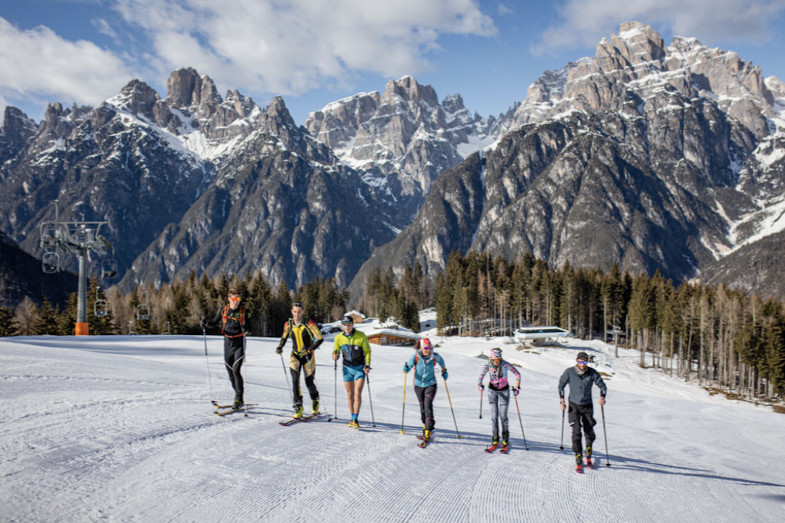
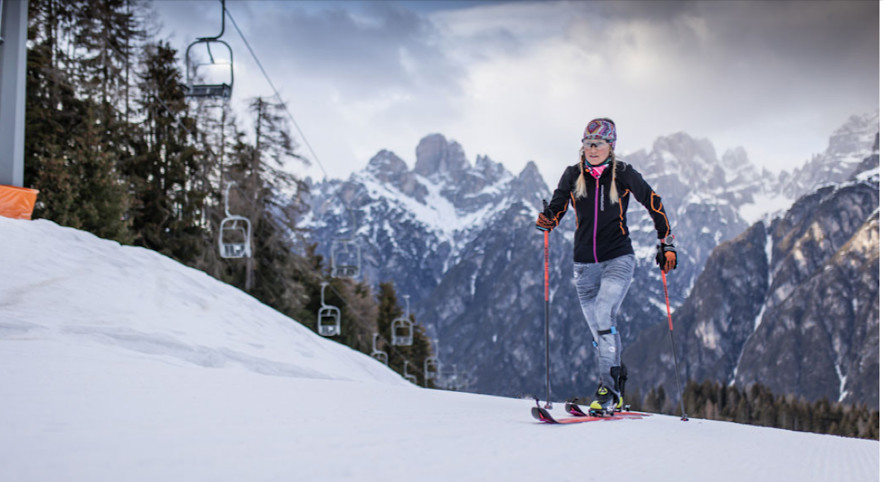
In Italy, and around Europe, Valmassoi is well known for her ski mountaineering prowess. Sponsored by Scarpa, she has been on the Italian national team for 10 years, and with French racer Latitia Roux holds the record for the fastest time in Italy's legendary Sella Ronda ski-mountaineering race. She has placed second at France's Pierra Menta ski-mountaineering race, and has stood on the podium of that internationally-acclaimed multi-day event three times.
I said, "Maybe I should try something crazy, like skiing for 24 hours just to see what happens!" My friend said, "You're crazy!" And we just kept skiing. That was the beginning of January. The idea never went away. Shortly after that, I decided to go for it.
Trail Runner magazine's Chamonix, France, correspondent, Doug Mayer, caught up with Valmassoi while she was resting-which seems like a relative term for her. She had just completed interviews with German magazines, Italian newspapers, Strava, Mountain Planet, and the French daily sports newspaper L'quipe-all during a cross-country drive to Trentino, Italy, where she was working as a freelance photographer at the Campiglio Ski Mountaineering World Cup race. During the interview only a solitary yawn hinted at the whirlwind week that Valassoi had just endured.
Trail Runner: 24 hours and over 17,000 meters is a lot of uphill skiing. Let me rephrase that. It's a $%&@(@ insane amount of skiing in a day. What inspired it?
Valmassoi: I was skiing in the mountains with a friend of mine, and it was my 50th consecutive day on skis. I thought, "Wow, I've been skiing for 50 days!" That had never happened before. I said, "Maybe I should try something crazy, like skiing for 24 hours just to see what happens!" My friend said, "You're crazy!" And we just kept skiing. That was the beginning of January. The idea never went away. Shortly after that, I decided to go for it.
What was the reaction when you told friends and family about your plans?
It was the same from everyone: "What the &*$^@?! What's happening to you?! Why this idea?!" It was pretty funny. My sister took a while to understand it and my mom started to worry that I would not make it.
How did you approach training for the event?
Honestly, nothing much changed. I wanted to do it my way and just ski as much as possible. I wanted to keep on exploring where I live, to get the most out of the winter. Of course, I tried to get in a lot of hours on skis. Even when the conditions were bad and the weather not good, the goal motivated me to get out.
But, you had to do some time at the ski area, right?
Yes. I didn't want to train that much on the slopes, but I knew I had to test myself there. I decided to do a test run a month before the event. I did a 5,000-meter day to see if I had the right slope and see how I did. It felt good and it gave me an idea of the pace I would need to set a record.
In the last month, I did a block of two weeks of training. I did 31,000 meters in those two weeks to create a good base. After that, I would train three times a week on the slopes. During that time, I organized the event and rested.
It was close to home, and steep with a good elevation gain. But, mainly, I picked it for the view! I have seen that view so many times, but every time I go up, I still stop and look. At the summit, I can turn around and see all the places I go on skis, and where I trail run in the summer.
It's incredible how much energy you can take from your surroundings and the mountains around your home. I have so many memories there. It all comes to my mind when I am up there.
Some resorts offered me money, but I don't know if I could have done this in another location. For me it wasn't so much about the record, as it was about doing it at home with friends. One of my main goals was to not be alone in this project, to involve family and friends. That made it really special.
Can you tell us about the logistics?
I decided to have the aid station at the top, because the bottom is in the shade and cold. I wanted my friends to have fun, and at the top there is the view and the hut, the Monte Agudo Refugio. So, my friends could stay warm in the refugio. The caretaker was super cool. He helped a lot.
Except for the first six or seven hours, I almost always had someone skiing up with me. Those times, I could go without my pack. Sometimes, I would listen to music on my phone. I would eat at the top or on the way down. On the climb up, I would bring a 250ml flask.
So how did it go?
It went great! I would never have imagined that it would go so well. You always wish for the best but you also have to expect the worst.
I had a plan, of course, and I wanted to keep up a certain pace-a lap an hour. I knew I could do that for the first 12 hours, but after that well, I had no idea. That was the scary part.
During the night, I kept the pace I wanted. I did have some problems. It was cold and windy, and I got cold. I kept my jacket on and decided I would rather sweat. I had to take a lot of bathroom breaks. I started to feel sick. I was worried. But I stayed positive and focussed.
From 10 p.m. to 6 a.m. I had a friend of mine, Michele Da Rin, who had his own personal challenge to ski through the night. He did 5,000 meters with me. Cheering him on gave me some extra motivation. I realized I was doing OK, if I was able to push him along, too!
You know, I felt pretty good all the time. I had some moments, of course. Sometimes it was not exactly hard, but it took more concentration and focus to stay on the pace.
What was the worst thing that happened?
It was probably prior to the event. Because of the pandemic, I had to plan everything really carefully. That was stressful.
How so?
Until right up to the start, I wasn't sure we could do it, because of the situation with Covid here in Italy. I let friends know of my plans, of course, but otherwise I kept it quiet.
To plan it, I had to give names of people who would be allowed there for support. I had to ask the Mayor if the hut at the top could stay open for us. He gave permission. That was really cool of him.
How did you fuel for a full 24 hours?
I prepared a food plan, though honestly it was kind of random. I tried to get real food every two laps, and I always tried to eat normal food between those bigger meals.
I prepared rice, polenta, chocolate and coconut bites, dates, dried fruit, toast, soup, potatoes and Spring gels. I had electrolytes to drink, plus ginger tea with sugar and lemon. Of course, by the end of it I was drinking a lot of Coke!
What's the reaction been like?
I've done a lot of interviews since I finished. My parents and friends were completely blown away. They had never seen an attempt like this.
I had a timekeeper who started out being kind of quiet, but later on he really got into it and was cheering me on. He was super stoked. For me, it gave me so much energy to see the faces of family and friends. Doing something so big with your friends and family makes it extra special.
Where does ski mo fit in with your trail running?
I'm more of a ski-mo athlete than I am a trail runner. Trail running is still kind of new for me. I started running as a way to train for ski mountaineering.
My trail running has improved, and I have moved into the longer races-I think because I like to train more slowly and enjoy the view! I think my best result was 2019 in the [Chamonix, France] Mont Blanc 90K. I got second place. I was really happy. That was a big goal and I surprised myself by finishing an hour earlier than I expected. I've had some other good results. In Kima, Italy, I was fifth in a really stacked field, after not much training. I want to do that race again. Tromso, Norway, I have finished third and fifth.
So what's next?
I need to process what just happened-to enjoy it. And I am still not sure how my body will react! Right now, my legs are really tired.
Soon, the trail-running season will start. Right now though, I want to rest. I don't always have to do something to be satisfied. After some rest, I will train for a cool summer adventure.
This was a big thing. It was, by far, the result I am most proud of in my athletic career. Normally I don't like to say this kind of thing, but I think I did a good job. I managed it well.
It took a lot out of me, but it also gave me more.
For someone who's reading this, and wants to try out ski mountaineering, what do you suggest?
Ski mo is really just backcountry skiing with skinny skis. If you like the backcountry, like to be in the mountains and want to train with plenty of vertical, it's great. Exploring with skis is something everyone should try. It gives you so much freedom.
Of course, you always need to be aware that the backcountry environment can be dangerous-more dangerous than in summer. There's a lot to check. You have to be concerned about things like avalanches. And I don't recommend starting by skiing for 24 hours!
What's important is learning skills. For example, the downhill is harder than the uphill. For me, though, ski mo is super fun. If you love trail running, you will probably like ski mo.
by Trail Runner Magazine
Login to leave a comment
Trail Runner Magazine says Moab Trail Marathon is one of their top Ten “bucket list†races
Login to leave a comment


